Today we’ll talk about the shelf life, storage, and spoilage of peanuts.
Found a leftover pack of peanuts in the pantry, and not sure if you can still eat them? They are “expired,” but look quite okay. Do peanuts go bad?
If you need a quick primer on peanuts to know what you should do with these nuts, you’re in the right place. Below, we’ll talk about how long peanuts last, what storage options you have, and how to tell if peanuts are bad.
Let’s dive in.
Peanuts are, technically speaking, legumes, not nuts. But they’re like nuts in many ways, so it’s easier to think of them as a part of that group. They’re similar to pine nuts and cashews in that matter.
Table of Contents
- Do Peanuts Go Bad?
- How to Tell if Peanuts Are Bad?
- How Long Do Peanuts Last?
- How to Store Peanuts?
- Can You Freeze Peanuts?
- Peanuts Shelf Life and Spoilage Summary
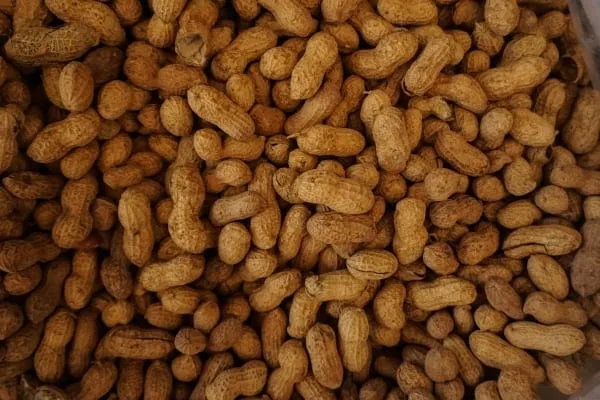
Do Peanuts Go Bad?
Due to their high-fat content, peanuts can go rancid. And that’s the most common reason one has to toss old peanuts. Rancidity sets in when you store nuts for too long or in suboptimal conditions.
When checking if your peanuts are rancid, look for the following:
- Altered taste. If yours taste sharp, bitter, or sour, that’s a sure sign of rancidity.
- Chemical (paint-like) or sour smell. If your peanuts smell like something else altogether, they are most likely rancid.
While the odor change is not always noticeable, it’s difficult to miss that repelling taste after it’s fully developed.
Fully developed, you ask?
Rancidity is a process that takes weeks or even months. That means the flavor of the nuts isn’t that different week to week, and in the beginning, you’ll only notice hints of bitterness that’s setting in.
It’s up to you what to do when you find that your peanuts taste a bit sharp or bitter. You can toss them right after noticing those early signs or use them until they’re undoubtedly rancid.
And in case you were wondering, peanut butter can go rancid too.
What Happens if You Eat Rancid Peanuts?
Most likely nothing.
Rancid nuts aren’t unsafe to eat, so eating one or two won’t make you sick or anything. A bad taste in your mouth is about the worst you should expect.
That doesn’t mean you should eat rancid nuts, though. Eating rancid foods isn’t good for you long-term, so tossing your rancid peanuts is best.
Finally, rancidity isn’t the only reason you might be forced to toss your peanuts. Let’s talk about others.
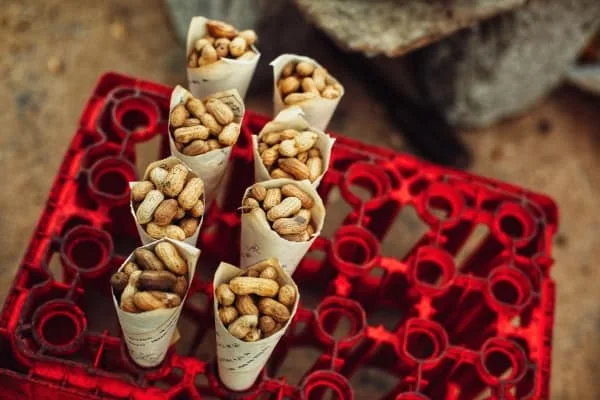
How to Tell if Peanuts Are Bad?
Signs of spoilage in peanuts include:
- Rancidity.
- Mold. Toss any moldy peanuts, and at the very least, discard all the nearby ones. If that mold was in a bag of shelled peanuts, it’s best to toss the whole bag. If you find mold after shelling a peanut, toss it and continue with shelling others after washing the tools you’re using. You don’t want that mold to spread.
- Pantry bugs. If some insects decided to snack on your peanuts, that’s game over for the nuts. Toss them and clean your pantry as soon as possible, as these things spread like wildfire.
If you store your peanuts properly (more on that later on), the chances of mold growth or bug infestation are quite small. That’s why rancidity is the most common sign of peanut spoilage.
Now, what if your peanuts aren’t spoiled but taste kind of stale? Should you toss them?
Not necessarily. Let’s talk about other options.
Using Stale Peanuts
If your peanuts sit in storage for a long time but haven’t developed that sharp and bitter taste, they’re probably stale. And while eating stale peanuts isn’t a health concern, they taste so-so at best, and you can do better.
Here are some ways of using stale peanuts:
- Toast them. Toasting nuts is the easiest way to freshen them a bit and bring back some of their flavor. You can heat them as-is or add some seasonings or sweeteners to the mix for extra variety. After that treatment, they should be snack-worthy once again.
- Make nut butter. Ever heard of peanut butter or Nutella? If you have a food processor, you can make your own in a few minutes. Now, if your nuts are quite stale, simply blending them won’t fix the issue. Instead, I suggest going with a recipe that includes a bit of salt and perhaps some honey to cover the nuts’ deficiencies. Like this one. Oh, and definitely toast the nuts beforehand.
- Fold into baked goods. Roughly chop the peanuts and add them to your favorite muffins, cupcakes, or banana bread. Almost any baked good can benefit from some chopped nuts.
- Top desserts. Diced peanuts work great with plain ice cream or any other dessert that lacks crunch. When adding the nuts, err on the side of adding too little, not too much. You don’t want to completely overwhelm the dessert with not-that-great peanuts.
As usual, if you’re worried that those stale peanuts will ruin whatever you’re cooking, do a test run and see how it goes. And if things don’t work out the way you’d like them to, you can always discard the nuts.
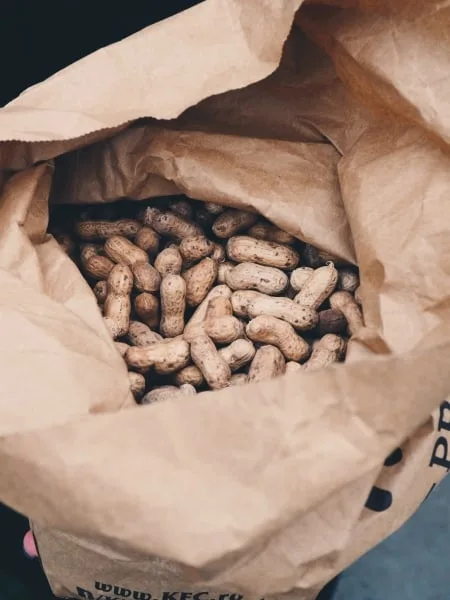
How Long Do Peanuts Last?
Shelled peanuts last for about 4 months at room temperature and about a year in the fridge, while in-shell peanuts keep for around 6 months at ambient temperature and more than a year if refrigerated.
You can also freeze both types of peanuts for over two years if those storage times aren’t enough for your needs.
These periods are only estimates, and if you take good care of the nuts, they should keep quality for longer.
The opposite is also true. If you leave shelled peanuts on the counter during summer when the temperatures often exceed 86°F (or 30°C), they’ll probably go rancid within a month or even sooner.
If you’re buying peanuts from bulk bins in a supermarket, assume that unless there’s high turnover, they aren’t the freshest.
Shelled vs. In-Shell Peanuts
Shells protect peanuts from excess air and sunlight, and provide some insulation from warm temperatures. That’s why the shelf life of unshelled peanuts at room temperature is a couple of months longer than one of their shelled counterparts.
So if you want to leave peanuts on the counter so that you can easily snack on them, buying in-shell ones is a better option if you care about them not going rancid. Plus, it’s much more difficult to overeat if you have to shell them when snacking.
If you plan on refrigerating or freezing the nuts, storage time is hardly different. That means it’s up to you if you prefer to buy peanuts shelled or like to do that yourself.
Toasted Peanuts
Toasting is a great way to enhance the taste of peanuts, but it also shortens their shelf life.
Unfortunately, it’s impossible to tell how long toasted peanuts last, so it’s best to either toast them as you go or freeze them after toasting. Either option ensures you won’t end up with rancid toasted peanuts.
The same is true for toasted pistachios (Do pistachios go bad?), macadamias (How long do macadamia nuts last?), and other nuts.
Flavored Peanuts
When it comes to flavored peanuts you buy in the supermarket, these usually come with slightly shorter storage times due to the processing they undergo.
Moreover, all that extra salt, seasonings, and sweeteners can often hide the fact that the nuts are rancid. After all, you barely taste them in these.
That’s why you should pay extra attention when eating “expired” flavored peanuts.
“Expired” Peanuts
If you buy bagged peanuts, they usually come with a best-by date printed on the label. That date isn’t an “expiration” date but rather an educated guess on how long the nuts should retain quality.
That means tossing peanuts just because they’re “expired” makes little sense.
Instead, you should examine them carefully, and if there aren’t any signs of spoilage present, assume they’re okay to eat. Even if they’re a couple of months past the printed date.
Of course, you can discard them the moment they hit their date, but I bet you wouldn’t be reading this article if that was your game plan.
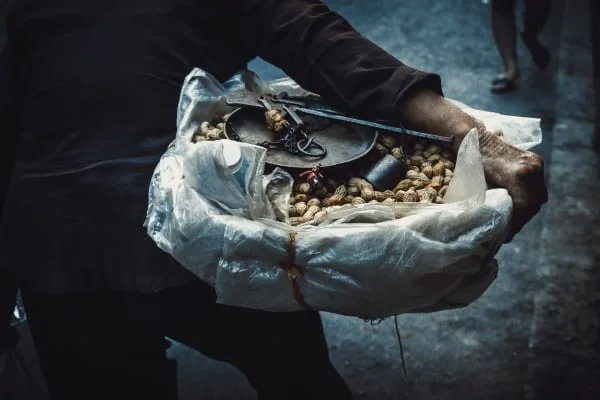
How to Store Peanuts?
For in-shell peanuts, use a ventilated bag if you leave them at room temperature, or opt for a freezer bag or container if refrigerating or freezing. Shelled peanuts, on the other hand, need to be sealed tight in a bag or container, no matter if you store them in the pantry, fridge, or freezer.
That’s the gist of it.
Unshelled
Store unshelled peanuts in a cool and dry place in a ventilated bag, or refrigerate them sealed well in a freezer bag or resealable container.
When stored at room temperature, in-shell peanuts should have free access to airflow so that any moisture can easily evaporate. That’s why a ventilated bag or storage basket is a great option.
If you decide to refrigerate unshelled peanuts, make sure they’re sealed well so they don’t pick up any moisture or mold.
Shelled
Keep shelled peanuts in a freezer bag or airtight container sealed tight. If you decide to store them at ambient temperature, pick a place that’s dark, cold, and away from heat sources. Or place that same bag or container in the fridge.
Shelled peanuts lack natural protection from the elements and pick up smells from other foods. That’s why they need a bag or container.
Whether you refrigerate them or leave them at room temperature is up to you, and the main difference is their shelf life (reread the shelf life section if need be).
So if you know that bag of peanuts will be gone in a few days or a couple of weeks, leaving them in a kitchen cupboard is no big deal. But if you expect them to sit around for months, it’s better to store them in the fridge from the get-go.
(The same considerations regarding storage are true for other nuts that are available both shelled and in-shell, including walnuts, hazelnuts, and pecans.)
Toasted or Flavored
Toasted and flavored peanuts have a shorter shelf life than plain raw peanuts, and that’s why I suggest you either refrigerate or freeze them. This way, they’ll keep for much longer than if left on the counter.
When it comes to how, you need to seal tightly toasted and flavored peanuts in a bag or container.
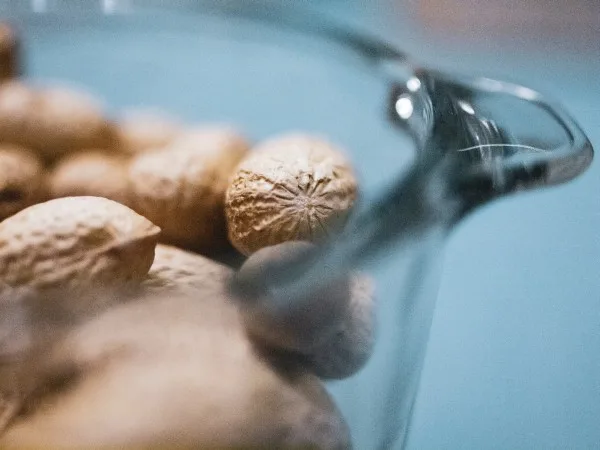
Can You Freeze Peanuts?
You can freeze peanuts, and if you want them to last as long as possible, freezing is the way to go.
Plus, the whole process is as simple as it gets.
Here’s how to freeze peanuts:
- Place peanuts in a freezer bag.
- Squeeze out the air and seal the bag.
- Freeze.
That’s it. The same steps work for both in-shell and shelled peanuts.
The only downside with freezing unshelled peanuts is that they take up a lot of space. So unless you have a giant freezer or rarely freeze anything at all, shelling the peanuts before freezing is a good idea.
How long can you freeze peanuts, you ask?
Frozen peanuts should retain quality for two years or more. That should be enough for you to go through your supply, even if you only eat or use a small amount each time.
When you’re ready to eat the peanuts, leave them on the counter for 30 to 60 minutes to bring them back to room temperature. Once defrosted, feel free to snack on them or use them in cooking.
Peanuts Shelf Life and Spoilage Summary
Thank you for reading this guide on peanuts. Here are the main points:
- Peanuts go rancid if stored for too long or in poor conditions. Other popular spoilage signs are mold and pantry pests, but rancidity is the most common one.
- Rancid peanuts taste harsh and bitter. They might also smell like old paint or putty, but that’s not always easily discernible.
- Shelled peanuts keep for about 4 months at room temperature and 12 months in the fridge. Unshelled ones last around 6 months unrefrigerated and more than a year refrigerated. Both can sit in the freezer for more than 2 years.
- You can store unshelled peanuts in a ventilated bag at room temperature or sealed in a freezer bag and the fridge. Shelled peanuts should be sealed tightly in a bag or container, no matter where you store them.